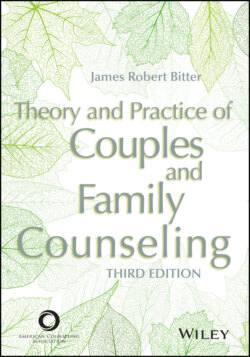Читать книгу Theory and Practice of Couples and Family Counseling - James Robert Bitter - Страница 47
Carl Whitaker
ОглавлениеCarl Whitaker and Murray Bowen were about as opposite in process as two family therapists could get. Bowen developed an elegant theory-based practice; Whitaker avoided theory in favor of developing the spontaneity of the therapist. Bowen preferred to work alone, focusing on coaching the most differentiated person in the family system; Whitaker most often worked with cotherapists. Bowen worked on big stages at NIMH and Georgetown University in Washington, DC; Whitaker started his career in Oak Ridge, Tennessee, and the largest institutions for which he would work were state universities.
Whitaker’s symbolic-experiential approach to family counseling, though certainly spontaneous, was not without structure. Whitaker’s approach to family counseling was similar to that of some existential therapists. He believed that families often got stuck in patterned responses, routines, and rules that stagnated the growth of both the system and the individuals within the system. He believed that real change did not occur without anxiety, so rather than providing warmth and acceptance, Whitaker and colleagues were much more likely to up the ante, seed the unconscious, and engage in the absurd. All of this was in the service of creating more flexibility in the family system, helping family members to be more human, and promoting real intimacy within the family.
Whitaker and John Warkentin started seeing families together at Oak Ridge Hospital in Tennessee between 1944 and 1946. In 1946, they left Oak Ridge to start the Department of Psychiatry in the medical school at Emory University in Atlanta, Georgia. Thomas Malone came to Emory to work with Whitaker, and together they would write one of the foundational texts for their approach to psychiatry (Whitaker & Malone, 1953/1981). Whitaker would also start to hold conferences twice a year in which family therapists primarily from the Philadelphia area would join his staff in demonstrations of counseling behind one-way screens— perhaps the first use of this method in the field. The last meeting in 1955 included Gregory Bateson and Don Jackson. Whitaker’s private practice in Atlanta, where he worked for 9 years, included colleagues John Warkentin, Thomas Malone, and Richard Felder. It was after his move to the University of Wisconsin at Madison in 1965 that his most important works would be published. Gus Napier and Whitaker (1978) teamed up to write what many consider one of family counseling’s masterpieces, The Family Crucible. Whitaker and David Keith would bring their work to the center of family counseling scholarship, and in the late 1980s, Whitaker and William Bumberry (1988; Bumberry & Tenenbaum, 1986) produced a video and book on Carl’s intensive work with a depressed family from the heartland of the United States.
At multiple conferences over many years, Whitaker and Salvador Minuchin sparred with each other professionally, both claiming to learn from and influence the other. By the time Carl Whitaker died in April 1995, he was one of the most revered practitioners in the field. (A chapter on Whitaker’s model is available at www.jamesrobertbitter.com.)
It is easy to see that until this point men dominated the origins of family counseling. This was true both in actual practice and in the orientation of the field. So at this point, I want to introduce the parallel stories of two of the first women to leave their marks on family counseling.
